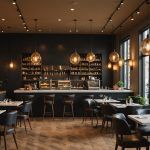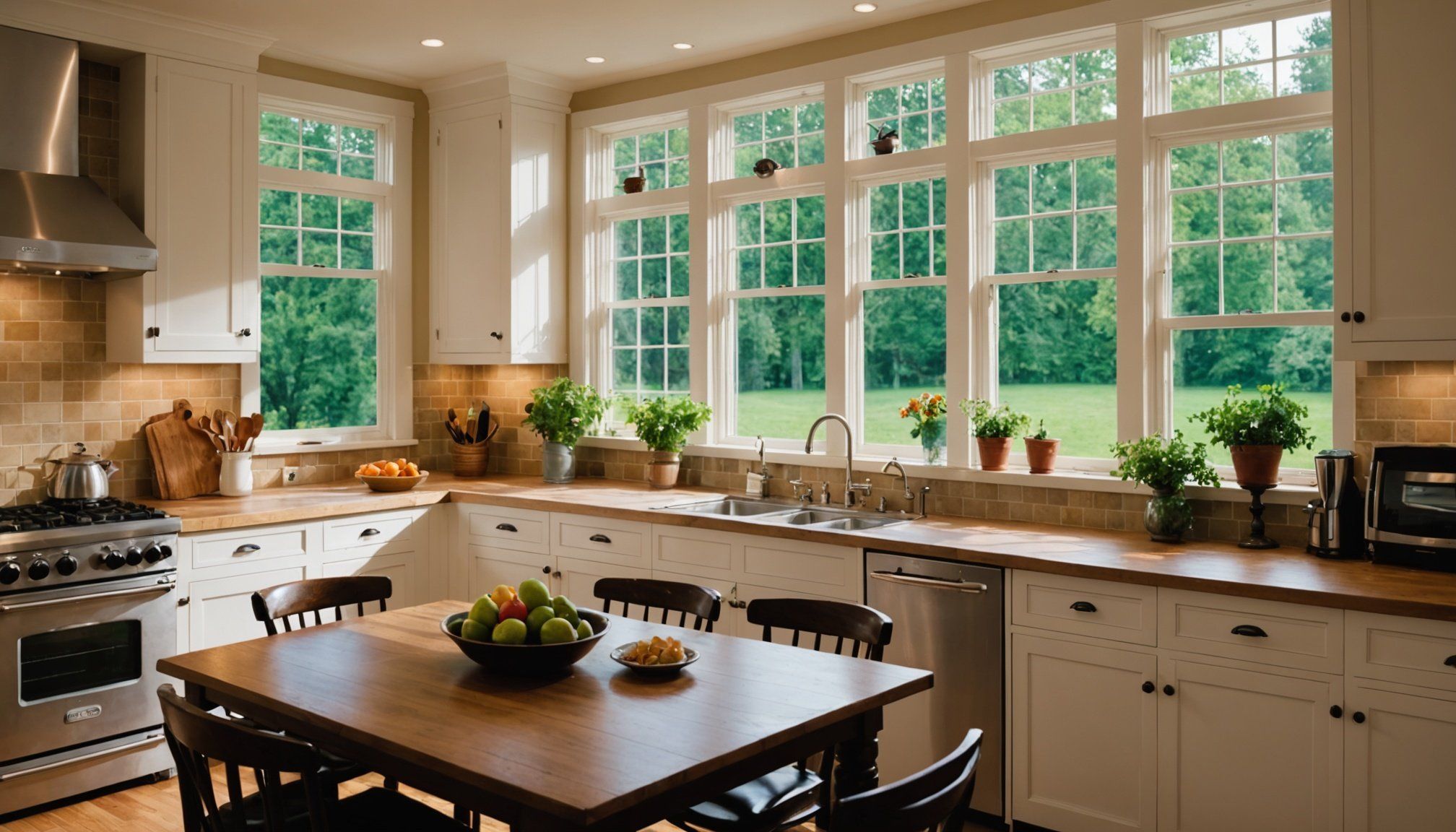The Impact of Kitchen Window Positioning on Dining Ambiance
Understanding kitchen window placement is vital for enhancing the dining ambiance. Natural light benefits are essential, providing a welcoming atmosphere that encourages relaxation and conversation. When strategically positioned, kitchen windows transform the dining area into a bright and inviting space by allowing sunlight to flood in during daytime.
Moreover, the views from the kitchen window can significantly enhance the dining experience. Imagine savoring your meal while gazing at a lush garden or a serene skyline. These vistas not only create an aesthetically pleasing atmosphere but also contribute to an overall sense of well-being and comfort.
Additional reading : Revitalize your kitchen with uplifting quotes: a fresh strategy for encouraging healthier eating choices
Window placement also influences the perception of space and comfort. Properly positioned windows can make a room feel larger, open, and more connected to the outdoors. This is particularly beneficial in smaller dining areas where the illusion of space is crucial.
By optimising kitchen window placement, you foster an environment that promotes both visual and emotional comfort. In summary, leveraging natural light and thoughtfully considering views can effectively elevate the dining experience, making each meal more enjoyable.
Also to see : Transforming your cooking experience: the impact of kitchen mat texture and color on comfort and fatigue relief
Practical Design Tips for Kitchen Windows
Designing kitchen windows with care can significantly transform your dining ambiance. Optimal window placement is essential for ensuring maximum benefit from both style and functionality.
Selecting the Right Style of Window
When choosing windows, consider styles that complement your overall kitchen design. Whether you prefer classic sash windows or modern casement types, the window’s design should harmonize with your existing decor. Prioritizing kitchen window design not only enhances aesthetics but also improves the coherence of the space.
Ideal Heights and Sizes for Maximizing Light
To maximize natural light, selecting windows of appropriate sizes and heights is crucial. Large windows allow more sunlight; however, their size should be proportional to the room. Consider placing windows at eye-level to balance privacy with light. Interior design tips recommend height adjustments to optimise light intake without sacrificing privacy.
Integrating Windows with Dining Area
For seamless integration, align kitchen window placement with key dining area elements. This alignment fosters a smooth flow between spaces, creating a unified environment that encourages relaxation and enjoyment. Pay attention to how the placement impacts pathways and sightlines, ensuring a harmonious transition that enhances the dining experience.
Case Studies: Successful Kitchen Window Implementations
Exploring kitchen design case studies reveals intriguing insights into effective window usage. One notable example is a home where panoramic windows seamlessly blend the indoors and outdoors, flooding the dining space with light and offering breathtaking views of the landscape. This integration not only enhances natural light benefits but also enriches the overall dining ambiance.
Another real-world example showcases a compact apartment that employs strategic kitchen window placement to maximize space perception. By opting for slim vertical windows flanking the dining area, the design creates an illusion of height, offering a sense of openness in what was previously a confined space.
Furthermore, examining diverse styles and placements is enlightening across various home types. For instance, in traditional homes, bay windows have been utilised for their ability to provide both aesthetic value and functional seating areas, further enhancing the dining experience.
The impact of these implementations extends beyond aesthetics. Homeowners report a more enjoyable dining experience; enhanced by the comforting presence of natural light and the engaging vistas framed by thoughtfully positioned windows. These case studies demonstrate the transformative power of well-considered kitchen window designs.
Expert Opinions on Window Positioning and Dining Habits
Expert insights illuminate how window placements profoundly affect dining habits. Home design professionals argue that strategic kitchen window placement is crucial for enhancing dining experiences. Interior designers often interview on the topic, highlighting how light performs in different room settings: a key factor in creating a harmonious space.
Interviews with Interior Designers
Renowned designers often stress the significance of aligning kitchen window placement with the dining area. By positioning windows to capture maximum natural light, they enhance both atmosphere and functionality. Aesthetically pleasing views, they suggest, can make dining moments memorable by elevating the room’s mood.
Insights from Psychologists on Light and Mood
Psychologists add another layer of understanding, noting how natural light benefits psychological well-being. They emphasize that exposure to daylight during meals can positively affect mood and reduce stress, thus enhancing the overall dining ambiance. This connection between light, mood, and dining enjoyment underscores the role of windows in home design.
Recommendations from Chefs on Kitchen Functionality
Chefs offer their unique perspective, often recommending window designs that complement kitchen workflows. They insist that well-placed windows can improve not just aesthetics but also practicality, aiding in cooking by providing needed natural light and ventilation. By aligning professional recommendations with homeowner needs, windows can optimise both form and function.
Visual Illustrations and Diagrams
Visual aids offer complementary insights into efficient kitchen window placements. Diagrams showcasing kitchen window illustrations can vividly depict how specific designs influence the dining ambiance. By visualizing layouts, one can better appreciate the overall aesthetic and functional impact of windows on a dining space.
Visualizations of light patterns play a critical role, elucidating how sunlight filters through different window styles and sizes. These diagrams can guide homeowners in selecting windows that maximize natural light benefits, contributing to a more inviting dining atmosphere. Seeing exactly how light interacts with a space helps in making informed decisions about window placement and design.
Comparative illustrations demonstrate the diverse effects of window designs on dining space layouts. By contrasting various design visuals, homeowners can explore different configurations and their implications. For example, an illustration comparing floor-to-ceiling windows versus smaller panes underscores how each impacts daylight entry and space perception.
These dining space layouts provide a tangible understanding of how strategic window positioning can elevate dining experiences, adding a layer of practical application to theoretical design principles. Visualization not only enhances comprehension but also empowers homeowners to envision their transformed spaces confidently.











